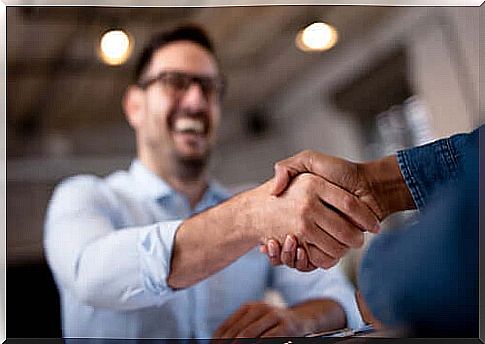Type Of Greeting And Personality

An interesting and significant detail about the personality is the type of greeting one adopts when meeting other people, depending on the socio-cultural context of belonging.
Beyond the cultural traits of each region, family or social group, the characteristics of each human being and of the bond that is established come into play in an act as symbolic as the greeting.

Type of greeting and sociocultural styles
Both the greeting that derives from a first meeting between two people who do not know each other and the greeting between people who have an emotional bond show a different style of relational expression.
- When you get together individuals who already know each other and who have a certain emotional relationship with each other, in France it is common to say goodbye with three kisses, regardless of whether they are men or women.
- The Spaniards, between men shake hands, at most they give each other a hug, while between women or between men and women they give each other two kisses.
- The Italians shake hands at the first meeting; if the people in question have not been in contact for a long time and a meeting occurs, then a hug comes.
- In Chile, in a more formal way, we greet each other with the hand between men and with a kiss between men and women. The same or happens in Peru and Bolivia.
- In Argentina it is customary to greet each other with a kiss between men and women who do not know each other from the first meeting.
- In Morocco, women cover themselves leaving only their eyes and ankles uncovered and walk at a distance from the man; obviously, under no circumstances will they show affection in public.
- Among the Orientals – and in particular the Chinese – the man and the woman walk away from each other : the man one or two meters in front of the woman and greet with a classic reverence, without any physical contact.
Women and men: differences in the type of greeting
It is evident the greater flexibility and less inhibition to physical contact that women show with each other compared to what happens among men.
At the same time the woman, especially if she belongs to the generation of the 60s, interposes a greater physical distance with men. Right from the 1960s, women started kissing each other, as well as walking hand in hand or arm in arm.
This attitude has since been identified as typically feminine, unthinkable among men. This is also because the man is identified with rationality and emotional distance, while the woman with sensitivity and affection. Still, we are living in an era of revolution.
Such discrimination foments stereotypes that inhibit the manifestations of affection on a physical level. It means that certain rules imposed by the context in which one lives make physical contact possible or not. The context, to some extent, prohibits or stimulates this aspect.
Type of greeting and familiar styles
Parents repeat the guidelines of the environment they are part of and strongly shape them from the first moments of interaction with their children.
And so the affective relational codes are outlined that specifically concern each family, but which give life to social stereotypes within them.
- There are families whose emotional interaction patterns require expressing physical affection in moderation. They are reluctant to hug, kiss, caress or simply look into each other’s eyes and prefer to show their affection in a material way. They are those families in which a “I love you” is expressed with a gift. Travel, clothing, money, flowers, etc. appear in its place.
- Others express affection in words. Members don’t give each other gifts, but they tell each other how much they love each other even if they never hug and kiss or caress.
- There are families whose affective code is represented by actions. Members help each other, do favors, understand each other’s needs, in short, they depend on each other.
- There are families who do not know inhibitions regarding physical contact and who express themselves emotionally by involving the body in this manifestation.

It is clear that the right counterweight in affective manifestations would be the result of the encounter between the various forms of expression and the most suitable channel according to the situation.
However, there is always a predominant style. There is a tendency to reproduce it in opposition or by similarity to the referential scheme of contact with the family of origin. That is to say, we tend to appropriate family dynamics and reproduce them in other relationships (especially in the new family that is created).
Type of greeting
The type of greeting gives useful clues about a person’s emotional sphere: the degree of malleability, ease or rigidity of physical expressions regarding feelings. We see below some special cases.

Some people do not hug, but formally wave their hand : if they are men, for example, they demonstrate their formality and their membership status, even more if they accompany the greeting with a social smile and the corresponding “With much pleasure”, as well as a classic outfit with garments that never go out of style.
There are people who greet with a vigorous squeeze and move their arm in a military style. They are those who greet a man with a handshake and women with a kiss.
The handshake
The intensity of the handshake is an interesting detail. Among men, in formal contexts they shake hands several times and in an immeasurable way, turning the phalanges of the interlocutors. They are memorable greetings for the pain caused.
Many people express their affection through the strength or roughness of their movements. They are quite crude and cannot express emotions except through roughness. A decisive greeting, with an intense gaze towards the interlocutor, expresses personal and relational security.
Sometimes people greet with a flabby, “slippery” hand. Shy, mainly, who do not like social contact and who do not dare to establish intimate relationships, preferring relational superficiality.
This type of greeting reinforces this hypothesis when the person looks from the other side rather than the eyes of his interlocutor while shaking hands; or when he simply glances or keeps his gaze down.
Phobia of social contact and delusions of control
People who take and offer only the tips of their fingers, who almost do not look into the face and who keep their eyes down as they prepare to take their seats, show an extreme phobia towards contact.
Some grab the interlocutor’s hand in its entirety and even place their left hand on the right hand of the one they greet. This type of greeting is a cross between a handshake and a hug.
They are individuals who show themselves more affectionate in contact even if, at certain times, their history and personality distortions describe people who are rather intrusive and with a tendency to control.
Sometimes we can come across sweaty hands, this aspect is a sign of nervousness and tension from the first meeting. There are people who make the greeting last a long time and who repeatedly move their hand from top to bottom. They are interminable greetings, in which it seems that our hand has remained attached to that of our interlocutor.
Although it can be a distinctive sign of one’s personality but also the fruit of anxiety, the greeting can reflect the social relationship: dependent, clingy, pretentious.
Conclusions
All these data offered by a first meeting demonstrate relational complementarity. Games and dynamics that a person will be able to interpret, to be verified in subsequent interactions if the relationship has a sequel.
Obviously these are generic speeches. In social games there are no generic schemes, but these demonstrations are exemplary hypotheses of how certain interactive styles should be interpreted. It means making the most of what empirical experience can offer us!









